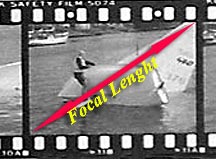Lenses Images created by home made Pinhole cameras, have a surprising degree of sharpness, and the inherent nature of these types of cameras will deliver extraordinary amounts of depth of field. Unfortunately the extremely small aperture used in pinhole cameras, will require that our exposure times even in bright sunlight be of the magnitude of several seconds. The only way to reduce the exposure time dramatically, is to increase the size of the aperture, however when we do this our sharpness level drops off significantly. So how do we solve the problem of short exposure times while retaining sharpness? The answer of cause is replace the pinhole with a Lens The elements of the lens are so designed as to not only focus the light while retaining a wide aperture, but eliminating and correcting distortions created by a wide aperture opening. As photographers we have at our disposal, three basic groups of lenses. These are know as the Wide, standard & Long. Restricting ourselves to 35mm film/digital cameras only, we see that the standard lens (focal length equal to the diagonal of the picture size) is usually designated 50mm. It is deemed standard, by the virtue that when we look through the viewfinder, the angle of view is approximately that of the human field of vision, about 46deg.
|
|

The wide angle groups is usually 35mm and down, while the long lens start at about 80mm and up.
Beginners assume that the function of the wide angle lens is to fit more into a frame. Where the function of the long lens is simply to enlarge distant objects. There is no denying that these are important uses of these lenses, however it is precisely because of these visual abilities, that the creative photographer can utilize the inherent nature known as "linear distortion" created by these groups of lenses.
We have now examined the basic tools of the camera. We have seem how apertures, shutter speeds, lenses and the light meter are able to help us express the visual story, well, not quite! We know what we want to do as far as the camera is concerned, the question now is where in the frame do we best place our main subject and where to place any secondary subject matter. Where in the frame will we be able to extract the maximum impact?